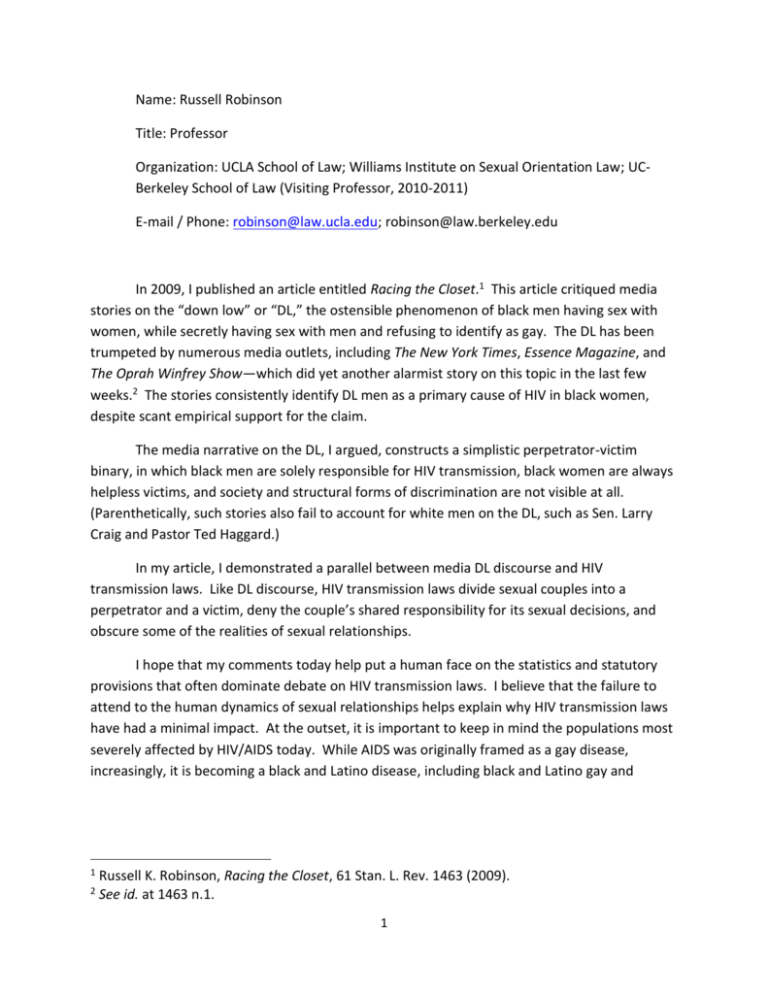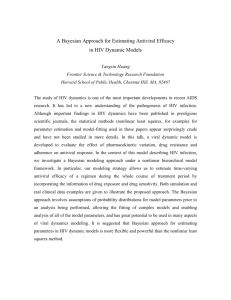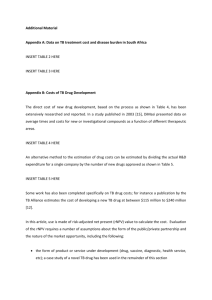
Name: Russell Robinson
Title: Professor
Organization: UCLA School of Law; Williams Institute on Sexual Orientation Law; UCBerkeley School of Law (Visiting Professor, 2010-2011)
E-mail / Phone: robinson@law.ucla.edu; robinson@law.berkeley.edu
In 2009, I published an article entitled Racing the Closet.1 This article critiqued media
stories on the “down low” or “DL,” the ostensible phenomenon of black men having sex with
women, while secretly having sex with men and refusing to identify as gay. The DL has been
trumpeted by numerous media outlets, including The New York Times, Essence Magazine, and
The Oprah Winfrey Show—which did yet another alarmist story on this topic in the last few
weeks.2 The stories consistently identify DL men as a primary cause of HIV in black women,
despite scant empirical support for the claim.
The media narrative on the DL, I argued, constructs a simplistic perpetrator-victim
binary, in which black men are solely responsible for HIV transmission, black women are always
helpless victims, and society and structural forms of discrimination are not visible at all.
(Parenthetically, such stories also fail to account for white men on the DL, such as Sen. Larry
Craig and Pastor Ted Haggard.)
In my article, I demonstrated a parallel between media DL discourse and HIV
transmission laws. Like DL discourse, HIV transmission laws divide sexual couples into a
perpetrator and a victim, deny the couple’s shared responsibility for its sexual decisions, and
obscure some of the realities of sexual relationships.
I hope that my comments today help put a human face on the statistics and statutory
provisions that often dominate debate on HIV transmission laws. I believe that the failure to
attend to the human dynamics of sexual relationships helps explain why HIV transmission laws
have had a minimal impact. At the outset, it is important to keep in mind the populations most
severely affected by HIV/AIDS today. While AIDS was originally framed as a gay disease,
increasingly, it is becoming a black and Latino disease, including black and Latino gay and
1
2
Russell K. Robinson, Racing the Closet, 61 Stan. L. Rev. 1463 (2009).
See id. at 1463 n.1.
1
bisexual men.3 With this impact in mind, how successful have HIV transmission laws been in
curbing the prevalence of HIV?
Overview of impact of HIV transmission laws:
1. A key study4 found a mere 316 prosecutions over 15 years (included published
judicial opinions and news reports).
2. There were roughly 21 prosecutions a year.
3. By contrast, there are 50,000 new infections each year (750,000 during 15-yr time
period).
4. Interestingly, from 1986-2001 one-quarter of the states had no prosecutions.
5. Prosecutions typically aimed at people who had broken additional laws, that is,
people already in the criminal justice system: at least 70%, according to one study. This focus
on people already within the criminal justice system likely has a disparate race and class impact,
although statistics on the identities of people who have been prosecuted are not available.
These numbers are even more striking when one considers the sweeping and
indiscriminate scope of many laws.
Some laws require disclosure of HIV status before engaging in many low or norisk activities, including mutual masturbation or penetration with a sex toy.
They apply to oral sex, which most public health experts consider to be low
risk.
They do not inquire into the HIV- status of the victim. In most states, an HIVpositive person commits a crime in not disclosing before sex, even if his partner
is also HIV-positive or does not know her status.
They do not require that the victim be actually infected through the exposure.
Mere exposure to a small risk of infection is a felony, in many states.
Most states do not consider whether the non-discloser used a condom.
They generally do not distinguish between high risk and low-risk sexual
activities.5
3
See, e.g., National HIV/AIDS Strategy for the United States, at 10-11.
Zita Lazzarini et al., Evaluating the Impact of Criminal Laws on HIV Risk Behavior, 30 J. L. MED.
& ETHICS 239, 241, 247 (2002).
5 See, e.g., id.; Carol L. Galletly & Steven Pinkerton, Conflicting Messages; How Criminal HIV
Disclosure Laws Undermine Public Health Efforts to Control the Spread of HIV, 10 AIDS BEHAV.
451, 455 (2006).
4
2
[See attached slide on differential risk of HIV infection based on sexual acts.] This variance in
risk demonstrates the impersonal nature of the statutes. They do not consider whether one is
a woman or a man, whether one is engaged in oral or anal sex, and whether one is engaged in
insertive or receptive sex. Qualitative studies show that real people take these factors into
account in deciding whether to ask about HIV status and whether to use a condom. Public
health workers counsel people to consider these factors and focus on harm reduction—shifting
people from high risk to low risk activities. Yet the laws are generally indifferent to these
questions. They wrongly imply that it is common to obtain HIV through oral sex or
masturbation, which exaggerates stigma, plays into public fears and undermines public health
interventions.6
Given the sweeping scope of these statutes, why do we see so few prosecutions? Why
do HIV transmission laws have such minimal impact?
I want to highlight two main reasons. First, they require knowledge that one is HIVpositive (but generally not intent to infect). However, many of the people who have HIV do not
know their status. As Cathy Cohen has demonstrated, the media and government initially
portrayed HIV as primarily a problem among white gay men and, secondarily, intravenous drug
users.7 This had adverse effects in that there are many men who have sex with men (or
“MSM”) who are not white and/or do not consider themselves to be gay.8
Further, many black heterosexual women contract HIV without being in a risk group. In
one study, 80% of women who contracted HIV through sex with a man did not know or report
that their male partners were in a high-risk group, such as drug users or bisexual men.9 These
groups—black heterosexual women, and non-white and non-gay-identified MSM—are
6
See Galletly & Pinkerton, supra note 5, at 457.
See CATHY J. COHEN, THE BOUNDARIES OF BLACKNESS: AIDS AND THE BREAKDOWN OF BLACK
POLITICS 125 (1999).
8 See, e.g., William D. Mosher et al., Sexual Behavior and Selected Health Measures: Men and
Women 15–44 Years of Age, United States, 2002, 362 ADVANCE DATA FROM VITAL & HEALTH
STAT., (Nat’l Ctrs. for Health Statistics), Sept. 15, 2005, at 1, 13 (finding that almost 4% of
Americans defined there sexuality as “something else” when the other options were
heterosexual, homosexual and bisexual and that blacks and Latinos were disproportionately
likely to choose “something else”).
9 See Chandra L. Ford et al., Black Sexuality, Social Construction, and Research Targeting ‘The
Down Low’ (‘The DL’), 17 ANNALS OF EPIDEMIOLOGY 209, 210 (2007).
7
3
particularly likely not to know that they are HIV positive. For example, consider a CDC study on
young black men who have sex with men in 6 major cities.10
This 2002 study surveyed 920 black MSM, ages 15-22. The researchers asked the men if
they knew their HIV status and then tested them. Overall, 16% tested positive. The key
findings are as follows:
93% of those who were positive were unaware of their infection.
Of those with unrecognized infection, 71% stated before testing that there was
no chance, that it was very unlikely or unlikely that they were infected with
HIV.
36% of the sample had never been tested for HIV; most of the remainder did
not test regularly.
Those who had an unrecognized infection and had recently engaged in unprotected anal
sex gave the following reasons for not using condoms:
They “knew” they were HIV-negative (24%).
They “knew” their partners were HIV-negative (20%).
They thought their partners were at low risk of infection (35%).
Condoms were not available (43%).11
As this study suggests, HIV transmission statutes miss the ball in assuming that all
positive people know their status. Through public health interventions, we can try to reach
people like the men in this study, who underestimated their risk and did not get tested
sufficiently. Studies suggest that about 25% of people living with HIV do not know of their
status.12 Moreover, HIV-positive people who are unaware account for a disproportionate share
of transmission to negative partners—at least half and as much as two-thirds.13 This is because
people who learn they are positive generally change their sexual behavior and may gain access
10
Ctrs. for Disease Control & Prevention, Unrecognized HIV Infection, Risk Behaviors, and
Perceptions of Risk Among Young Black Men Who Have Sex with Men—Six US Cities, 1994-1998,
51 MORBIDITY & MORTALITY WKLY. REP. 733 (2002), reprinted in 288 J AM. MED. ASS’N 1344,
1347 (2002).
11 This finding suggests an alternative public policy approach—make free condoms widely
available and emphasis the importance of condom usage regardless of whether the partner
discloses his or her HIV status.
12 See, e.g., Gary Marks et al., Estimating Sexual Transmission of HIV from Persons Aware and
Unaware that They Are Infected with the Virus in the USA, 20 AIDS 1447, 1447-1449 (2006).
13 See Gary Marks et al., Meta-Analysis of High-Risk Sexual Behavior in Persons Aware and
Unaware They Are Infected with HIV in the United States, 39 J. ACQUIRED IMMUNE DEFICIENCY
SYNDROME 446, 448 (2005).
4
to medication [highly active antiretroviral therapy [HAART], which can reduce their viral load to
low or undetectable levels.14 However, HIV transmission statutes work at cross-purposes with
this goalif people know about the law, they may avoid learning their status because of the
legal risks attached to knowledge.
Another second reason for the failure of HIV transmission laws is that they are generally
out of synch with the realities of many sexual relationships and the shared responsibility for
dealing with HIV. As I describe in Racing the Closet, there are three themes that emerge from
the literature on condom usage and safe sex negotiation. First, sexual partners often do not
discuss HIV and under some circumstances, the positive and negative partner might act under
contradictory assumptions.15 Instead of encouraging all people to ask about HIV status and use
condoms, as public health experts do, HIV transmission statutes place the burden entirely on
the positive partner. This may lead a negative person wrongly to assume that his partner would
say something if he were positive, even though the other might assume that if his partner were
negative and intent on staying negative, he would bring up HIV or condoms.
Second, relationship status matters. The degree of intimacy in a relationship appears to
determine the extent to which a positive partner discloses his HIV status, but intimacy also
increases the likelihood of unsafe sex. Positive men are most likely to disclose when in a
relationship, while they tend to feel a lesser obligation to casual sexual partners.16 But
disclosure does not always lead to safe sex. HIV transmission statutes are wrong to assume
that if a person discloses that he is positive, the negative partner will react by demanding
condom usage. For example, a study of heterosexual male and female college students
indicated that the more positively subjects felt about their sexual partner with respect to love,
trust, and commitment, the less likely they were to be influenced by the fear of AIDS in deciding
whether to use condoms.17 The law’s general failure to say anything about condoms, and focus
solely on disclosure as a cure-all, is a serious mistake.18
Third, context matters. Positive people may assume that sex partners in certain casual
sex markets, such as gay neighborhoods like the Castro in San Francisco, public sex venues or
sex clubs, are themselves positive or expect not to have a discussion about HIV before sex.19
14
See id.
See Robinson, supra note 1, at 1522-1523.
16 See id. at 1524.
17 Constance J. Pilkington et al., Is Safer Sex Necessary with a “Safe” Partner? Condom Use and
Romantic Feelings, 31 J. SEX RES. 203 (1994).
18 See, e.g., Robinson, supra note 1, at 1531.
19 See id. at 1524-1525.
15
5
I raise these issues not to suggest that the HIV-positive partner has done nothing wrong
if he fails to disclose his HIV status, but to argue that the other partner might share some
responsibility. This discussion also illuminates reasons why the other partner might not press
charges even if she learned of the illegal failure to disclose. Such a person might accept some
responsibility for failing to insist on using a condom in light of a context indicating heightened
risk. Especially where the person does not become infected as a result of unprotected sex
(which is entirely probable based on a one-time exposure), she is likely not to turn to the
criminal law and submit to the invasion of privacy required to bring a case against her HIVpositive sex partner.
I hope that I have shown that HIV transmission laws are not an effective or
comprehensive means of reducing HIV transmission. Indeed, in addition to leading to just a
handful of prosecutions, they may be counter-productive in signaling that only HIV-positive
people are responsible for transmission and giving people who are uncertain of their HIV status
a reason not to know. Instead of tinkering with these laws, government should attack the race
and class disparities that shape HIV transmission and health care through public health
interventions. HIV transmission statutes, however, are likely to distract from, and potentially
undermine, such efforts and give legislators a false sense that they have reduced HIV
prevalence. Thank you.
6





